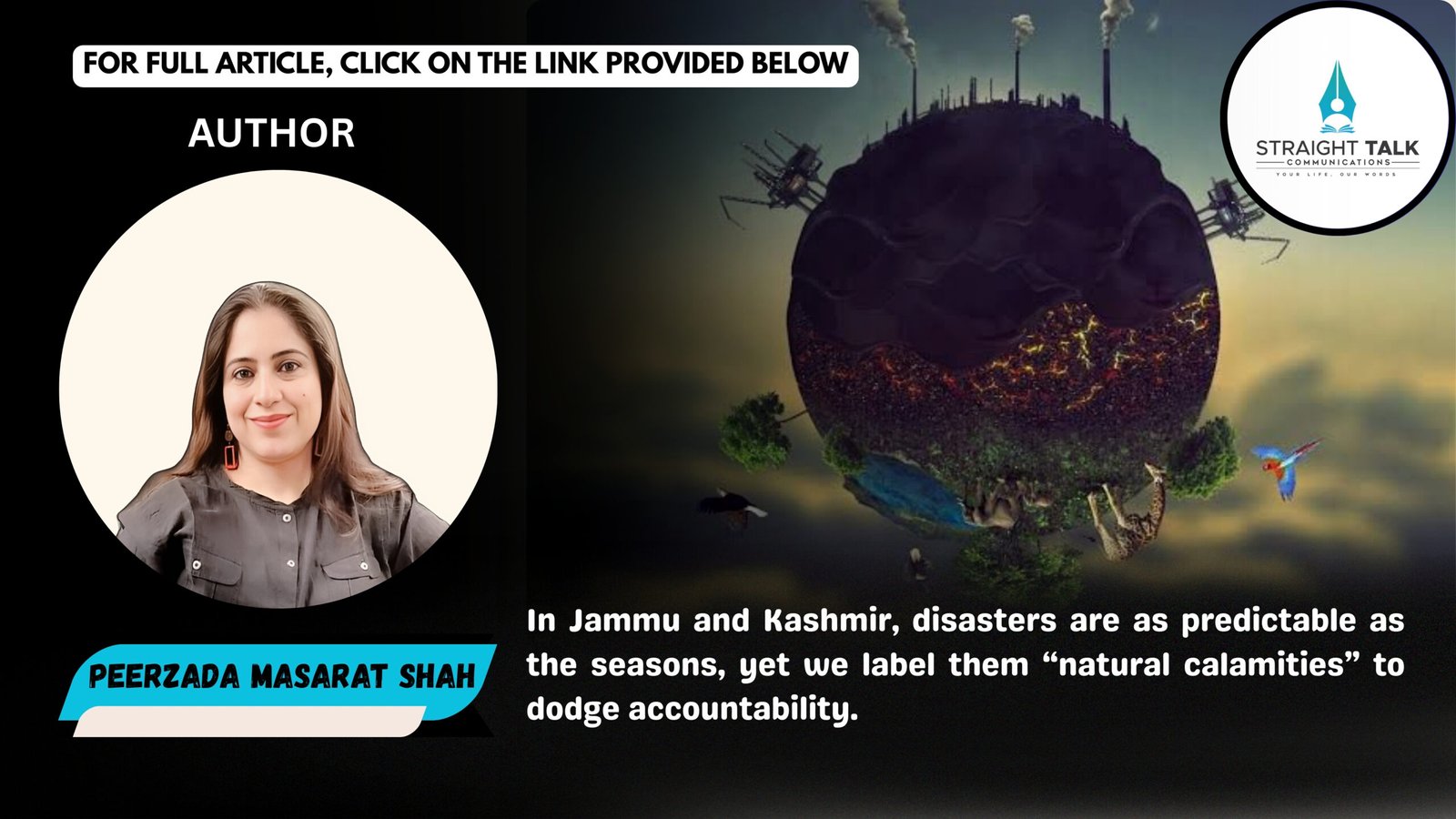Nature’s Wrath or Human Hubris? Kashmir’s Recipe for Disaster

Peerzada Masarat Shah
In Jammu and Kashmir, disasters are as predictable as the seasons, yet we label them “natural calamities” to dodge accountability. Floods? Blame the rain gods. Landslides? Curse the mountains. A river drowning in garbage? Surely, that’s divine punishment. This convenient narrative lets us sidestep the real culprits: greed, negligence, and apathy.
Last week, floods ravaged parts of Jammu, claiming over 30 lives and displacing thousands. A devastating landslide buried 34 Vaishno Devi pilgrims alive on August 24, 2025, near Ardhkuwari. News outlets screamed “Nature’s Fury,” while officials played the role of saviors. But let’s be honest: these aren’t acts of God—they’re the predictable fallout of human folly.
The Jhelum: From Lifeline to Landfill
The Jhelum River, once Kashmir’s pride, is now a floating garbage dump. On August 20, 2025, locals reported its waters hidden beneath a mosaic of plastic bottles, polythene bags, and rotting waste. For older Kashmiris, who recall fishing in its clear currents, it’s a heartbreaking betrayal. For the youth, it’s just a dirty drain, unworthy of a second glance.
Tourists, lured by the promise of “paradise on earth,” contribute to the mess, tossing snack wrappers and water bottles from shikaras. Locals are no better—household waste is routinely dumped into the river. As one Srinagar shopkeeper tweeted:
“Jhelum is choking on our trash. Used to swim in it as a kid, now it’s a landfill. We did this. #SaveJhelum
@KashmirVoice, August 21, 2025
A 2023 study by the University of Kashmir estimated that 70% of the Jhelum’s pollution comes from untreated sewage and solid waste. Despite this, waste management systems remain woefully inadequate, with only 20% of Srinagar’s garbage collected daily, per a 2024 civic report.
A Disaster Script Written in Stone
The region’s floods and landslides follow a tired playbook. The 2014 floods, which killed over 400 and displaced 1.5 lakh people, exposed the dangers of encroachments on the Jhelum’s floodplains. Yet, in 2025, illegal colonies still dot the riverbanks in Jammu and Srinagar. The Tawi River in Jammu faces similar violations, with over 1,000 unauthorized structures reported in a 2024 survey by the Jammu Development Authority.
When heavy rains hit on August 22, 2025, the outcome was inevitable: the Jhelum and Tawi overflowed, bridges in Udhampur collapsed, and homes in Doda were swept away. The India Meteorological Department (IMD) had issued a red alert for heavy rainfall, but preparedness was absent. A local journalist tweeted:
“Same story every year. Rivers encroached, warnings ignored, people die. When will we learn? #KashmirFloods”
@ValleyTruth, August 23, 2025
The Himalayas, geologically young and fragile, can’t withstand our reckless exploitation. Deforestation—over 15,000 hectares lost in Jammu and Kashmir since 2010, per Forest Survey of India data—combined with unchecked construction of hotels and tunnels, destabilizes slopes. Yet, we act surprised when landslides bury villages.
Pilgrimage or Peril?
The Vaishno Devi landslide was no freak accident. The IMD’s August 20 forecast warned of heavy rainfall, and the new Himkoti track was closed preemptively. Yet, the old Ardhkuwari route, known for its cracked, unstable paths, remained open until noon on August 24 to keep the pilgrimage—and its revenue—flowing. The result? Thirty-four pilgrims perished under mud and stone.
This tragedy echoes past warnings: the 2021 Reasi landslide that killed eight pilgrims, the 2013 Kedarnath disaster that claimed over 5,000 lives, and recurring cloudbursts in Pahalgam. A pilgrim tweeted post-tragedy:
“Survived Vaishno Devi but saw death up close. Why wasn’t the route closed? Money over lives? #VaishnoDevi”
@PilgrimSpeak, August 25, 2025
The shrine, which sees over 80 lakh visitors annually (Shri Mata Vaishno Devi Shrine Board, 2024), generates significant revenue. Closing routes, even temporarily, means financial losses—a choice authorities seem unwilling to make.
Blame Game and Collective Amnesia
Governments are quick to vilify the weather while posing as rescuers. After the floods, officials announced “high-level meetings” and “relief funds,” but tangible action remains elusive. Citizens aren’t blameless either. We dump garbage into rivers, build homes on unstable slopes, and shrug when disaster strikes. A Srinagar resident summed it up:
“No dustbins, no civic sense. We throw trash in Jhelum and expect it to stay clean. #KashmirDisaster”
@SrinagarCitizen, August 22, 2025
The 2014 flood management project, budgeted at Rs. 1,600 crore, promised to dredge the Jhelum and enforce zoning laws. As of August 2025, only 30% of the project is complete, per a government audit. Early warning systems are patchy, and waste management is virtually non-existent in rural areas.
The Human Toll
Behind the headlines are real tragedies: a father swept away in the Chenab, a family in Rajouri buried under their collapsed home, a pilgrim crushed on a sacred journey. Official records reduce them to statistics, their loss compensated with paltry cheques—Rs. 4 lakh for a life, per 2025 disaster relief norms.
Meanwhile, the cycle of calamity fuels a perverse economy. Contractors profit from half-finished projects, and officials thrive on relief budgets. For them, disaster is a business. For the people, it’s survival.
The Bitter Truth
Let’s stop calling these “natural disasters.” Nature provides rain and rivers; we provide the encroachments, corruption, and indifference. The Jhelum didn’t choke itself—our garbage did. The Vaishno Devi pilgrims weren’t killed by rain but by the decision to prioritize profit over safety. The floods don’t return because of monsoons alone but because we pave over floodplains.
Kashmir’s disasters aren’t natural—they’re manufactured. Until we own up to our role, the Jhelum will keep suffocating, mountains will keep crumbling, and lives will keep slipping away. We’ll mourn, tweet condolences, and move on—until the next tragedy.
But as one local poet tweeted:
“God didn’t flood our homes or bury our pilgrims. We did. Time to stop blaming the sky. #KashmirWakesUp”
@PoetOfTheVale, August 26, 2025
The question is: will we wake up before the next disaster strikes?







